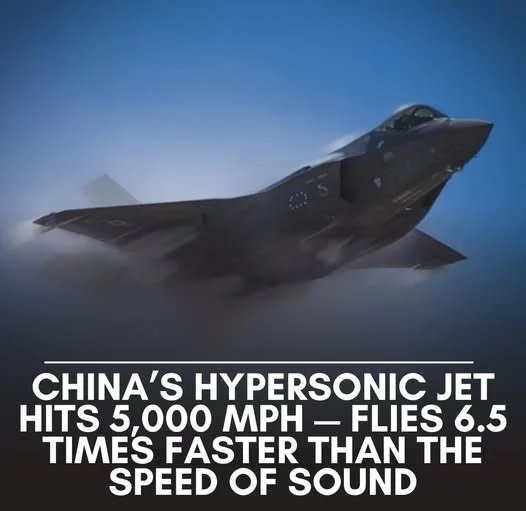Recently, China unveiled an astonishing breakthrough in supersonic aviation with a jumbo supersonic jet capable of flying at Mach 6.5 — equivalent to about 5,033 miles per hour. Developed by researchers at the Chinese Academy of Sciences, this aircraft differs from traditional supersonic models with its sleek aerodynamic design. Instead, it focuses on optimizing space for passengers and cargo, a crucial factor if this technology is to be applied in commercial aviation.
During a test flight in 2021 at the Jiuquan Satellite Launch Center, the prototype of this jet reached a speed of Mach 6.56, more than six times the speed of sound. Although the test flight lasted only 20 minutes, the results demonstrated that this is not a mere fantasy but a significant step toward a future of rapid and convenient air travel.

This speed could completely transform global transportation. If this technology succeeds and is widely adopted, the flight time from Beijing to New York could be reduced to 2 hours, compared to the current 13 hours. This marks a major breakthrough in cutting travel time between continents, something that was once only imaginable.
However, significant challenges remain. This supersonic technology requires advancements in materials, engine technology, and energy systems to maintain long-term and stable performance. Experts note that perfecting this technology will face issues such as the heat resistance of materials at extreme speeds, as well as the development of an efficient and durable energy source for a large commercial aircraft.
According to researchers, this technology is currently funded by the National Natural Science Foundation of China. The scientists hope that with continued investment, they can resolve the remaining issues and even move toward the next goal: global travel in one hour. Once perfected, this technology will not only shorten flight times but also revolutionize the aviation industry, enhancing global connectivity and boosting international economic development.
“We believe that this supersonic jet will serve as the foundation for the future of aviation, making ultra-fast flights a reality,” said Li Zhi, head of the research team at the Chinese Academy of Sciences, in an interview with China Daily in January 2023.
This photo shows the prototype of China’s supersonic jet during testing at a satellite launch center. The test flight demonstrates the potential of this technology, offering hope for the future of aviation.
However, not everyone is optimistic. Some experts warn that the development of this technology could bring significant environmental and safety concerns. Although it holds great promise, implementing supersonic technology for daily use will require solving a series of sustainability and cost-related issues.
Meanwhile, researchers continue to optimize the design while receiving special attention from the international community regarding its potential. Aviation specialists believe that if successful, this technology will not only reduce flight times but also completely transform the aviation sector, ushering in a new era of ultra-fast and time-saving flights.
A simulation of a supersonic flight from Beijing to New York in just 2 hours would not only save time but also open up opportunities for economic development, promoting trade and enhancing global cultural connections.
With rapid technological advancements, we are closer than ever to the possibility of intercontinental travel in extremely short times, heralding a new era for global aviation. However, many issues still need to be addressed, especially ensuring safety and efficiency in supersonic flights.


HPX24h > Science > China’s Hypersonic Jumbo Jet Could Cut Beijing to New York Flight Time to Just 2 Hours
Top Reads from This Category
Science
Discovery of a New Stem Cell: A Major Advancement in Creating Human Organs
Science
Gold in the Human Body: A Scientific Look at the ‘Hidden Gold’ Inside You
Science
Artificial Hearts and a Future Without the Need for Transplants
Science
Extinct Black Rhinos Could Make a Comeback with Genetic Technology
Science
Stem Cell Therapy for Lung Cancer: A New Hope Entering Human Trials
Science
Discover Blood Testing Technology Without a Visit to the Doctor
Science
Science Could Regrow Your Lost Arm… on a Monkey’s Body
Discover New Topics
Animals
The Way African Ants Use Venom to Paralyze Prey from a Distance
Healthy Eating
Essential Nutrition: The Golden Key to Comprehensive Health
Animals
The Secret Behind Turtle Eggs Hatching at the Same Time: A Fascinating Reason
Science
Direct Brain-to-Brain Communication via the Internet
Health
Are ‘Forever Chemicals’ Present in Bandages? How This Could Affect Your Health
Parenting Tips
How to Talk to Your Child About Divorce: Helpful Tips for Parents
Fitness
Effective Workout Tips: The Best Full-Body Exercises for Health
Fitness
Walking or Running: Which Is Better for Health and Weight Loss?
Parenting Tips
Sleep Apnea in Preschoolers: Understanding It to Protect Your Child’s Health
Science
Work 3.5 Days a Week and Live to 100: This Could Be Your Future
Health
Natural Remedies for Stomach Pain Every Parent Should Know
Healthy Eating
Vegan Keto Diet: Everything You Need To Know
Healthy Eating
Gallbladder Protection Through Diet: Expert Guide and Practical Tips